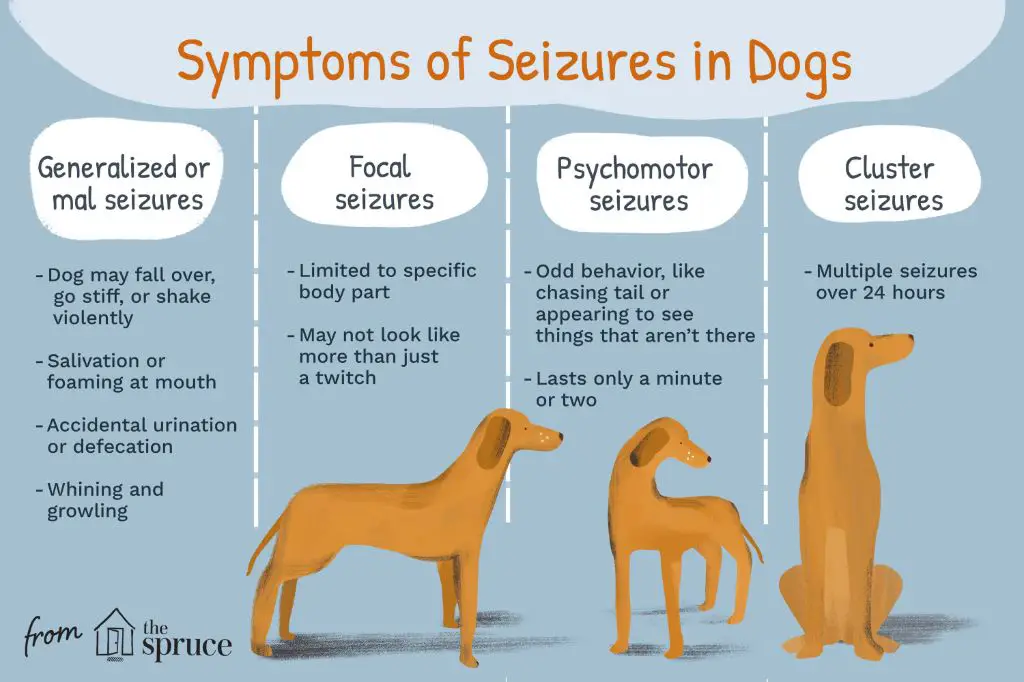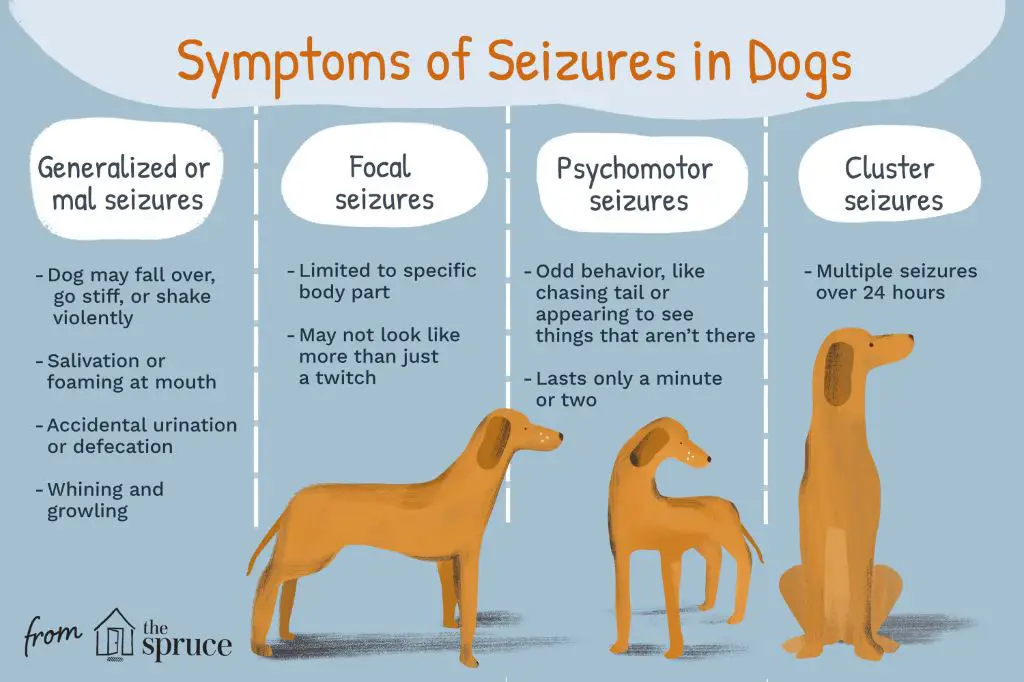Introduction
A seizure is a sudden, uncontrolled electrical disturbance in the brain. It can cause changes in your dog’s behavior, movements, feelings, sensations, and consciousness. Seizures in dogs are usually the result of abnormal electrical activity and can have a variety of causes. Most seizures in dogs last 1-2 minutes and do not cause long-term harm. However, it’s important to understand what your dog may experience during a seizure and recognize common after-effects. This will help you provide the best care for your canine companion.
Physical Sensations
A seizure causes intense physical experiences and uncontrolled body movements for a dog. During the tonic phase, the dog’s muscles will suddenly tense up and their legs will stiffen and extend outwards, which may cause the dog to fall over. The clonic phase involves rapid muscle contractions that will make the dog’s entire body shake or jerk uncontrollably. Their head and neck may turn or twist in odd positions repeatedly. The dog may experience muscle spasms in their facial area leading to chomping motions with their jaw or foaming at the mouth. Saliva or froth may also build up and be expelled from the mouth or nose. The repeated convulsions during this phase often lead to paddling of the dog’s limbs as if they are running. Some dogs even temporarily lose control of their bladder or bowels during the seizure.
Loss of Consciousness

During a seizure, a dog experiences a temporary loss of consciousness and awareness of their surroundings. This occurs because the excessive electrical activity in the brain disrupts normal function, preventing the brain from processing sensory information and thoughts properly.
For the duration of the seizure, the dog is essentially disconnected from their environment. They are unable to focus, respond to stimuli, or control their body movements. Their gaze may appear glazed over and unseeing as brain activity is focused internally. The dog is unaware of any movements, vocalizations or other behaviors they may exhibit during this time. They have no cognition or perception of what is happening to them or around them.
Essentially, for those moments the dog blacks out and loses awareness entirely. The loss of consciousness during a seizure stems directly from the abnormal electrical activity disrupting the brain’s ability to function normally. Once the seizure ends and the brain activity stabilizes, consciousness gradually returns. But while the seizure is occurring, the dog is completely detached from any conscious experience of what is happening.
Vision Changes
Dogs can experience a variety of vision changes before, during, and after a seizure. In some cases, changes in vision may be an early indicator that a seizure is about to occur. For example, some dogs may start staring off into space, become distracted by visual stimuli that would not normally catch their attention, or appear to track something across the room that is not physically there.

During the seizure itself, dogs often lose awareness of their surroundings and their vision goes dark or blurry. Their eyes may dilate or move rapidly from side to side. Some dogs appear to be staring at something while others close their eyes tightly. In most cases, dogs are essentially blind during the seizure episode itself.
After the seizure ends, vision generally returns to normal fairly quickly. However, some dogs may experience temporary blindness or have dilated pupils for a period of time afterwards. Their eyes may be sensitive to light or they may still appear distracted by visual stimuli around them. These vision changes typically resolve within a few hours but can be signs of residual seizure activity.
Any unusual vision changes, either leading up to, during, or after a seizure episode are worth discussing with your veterinarian. Tracking these details can help identify patterns and warning signs to look out for in the future.
Hearing and Other Senses
During a seizure, a dog’s hearing and other senses are often affected. Since seizures involve abnormal electrical activity in the brain, the brain cannot process sensory information normally.
A dog’s hearing may become dulled or muffled during a seizure. The dog may not be able to interpret sounds properly or localize where sounds are coming from. Their ears may ring or they may hear phantom sounds that aren’t actually there.
In addition to hearing changes, a dog’s sense of smell, taste, touch, balance, and proprioception (body awareness) are also impacted. They may have altered perception of smells, flavors, temperature, textures, motion, and body position. Everything is essentially scrambled and not conveyed properly to the brain during the seizure.
These sensory changes, combined with the loss of consciousness and motor control, create an extremely disorienting experience for dogs. Coming out of a seizure, they are often frightened, confused, and unsteady until their senses can recalibrate.
Distress Signals
During a seizure, dogs often exhibit signs of fear, anxiety, and distress. Here are some common distress signals dog owners may notice:
-
Whining or crying – The seizure causes confusion and discomfort. Your dog may whine or yelp.
-
Pacing or seeking comfort – Before or after a seizure, dogs may pace restlessly or cling to their owner.
-
Hiding – Some dogs may try to crawl under furniture or hide in a corner. The unfamiliar sensations scare them.
-
Loss of bladder/bowel control – Involuntary urination or defecation sometimes occurs. Your dog may be frightened and ashamed.
-
Excessive salivation or drooling – This involuntary reaction can further upset some dogs.
-
Loss of appetite – The stress of a seizure often causes dogs to reject food temporarily.
-
Trembling, cowering, or shaking – The seizure and after-effects frighten the dog.
While distressing to witness, these behaviors are natural responses. Stay calm and offer gentle comfort to help ease your dog’s anxiety.
Aftermath
Once the seizure ends, the dog may seem disoriented, tired, and unsteady for a period of time. They may pace, wander around, or look confused about their surroundings. Some dogs may temporarily lose vision or hearing after a seizure. There is usually rapid breathing and panting immediately after the episode finishes.

The dog will likely have impaired movement and poor coordination for a while following the seizure. Their legs and body may shake or tremble. The dog may drool excessively or vomit after the seizure concludes. They may lose control of their bladder or bowels temporarily.
Mentally, the dog appears drained, dazed, and tired after an intense seizure. They may seem fearful or anxious and want to be comforted. The dog may seek to hide or withdraw following the episode. They may be clingy and want contact with their owner. The dog’s brain essentially needs to “reboot” and regain awareness of their surroundings after the seizure ceases.
The after-effects of the seizure usually pass within hours as the dog recovers from the intense electrical disturbances in their brain. They may be sleepy, subdued, or even sleep for an extended period after the seizure. With rest and time, the dog can recuperate both physically and mentally after the exhausting effects of the seizure.
Behavioral Changes
Seizures can sometimes alter a dog’s personality and behavior. This is because seizures affect the brain, which controls mood and actions. Some common behavioral changes after a seizure include:
- Confusion and disorientation – Dogs may seem dazed, stare blankly into space, get lost in familiar surroundings, or not recognize family members.
- Anxiety and restlessness – Seizures are frightening for dogs, so they may pace, seem nervous, hide, or want extra affection afterwards.
- Aggression – Some dogs become irritable or even aggressive after seizures. This is often due to post-seizure disorientation.
- Attention-seeking – Dogs that experience seizures often become more clingy and attention-seeking.
- Lethargy – It’s normal for dogs to be tired and sleepy after a seizure due to the physical and mental exertion.
- Changes in appetite – Appetite may decrease after a seizure, or dogs may drink and urinate more.
If behavioral changes last more than a day or two, or seem extreme, it’s a good idea to notify your veterinarian. Ongoing personality changes could indicate brain damage or neurological problems.
Health Risks
Seizures can sometimes be indicative of underlying health issues. Some potential health risks and conditions that seizures may signal include:
– Epilepsy – Recurrent, unprovoked seizures are a hallmark sign of epilepsy. Epilepsy is a chronic neurological disorder that causes abnormal electrical activity in the brain leading to seizures.

– Brain tumor – Brain tumors located in certain parts of the brain that control electrical activity can sometimes trigger seizures. Seizures caused by brain tumors tend to be focal (confined to one area of the brain) rather than generalized.
– Stroke – Seizures during or after a stroke may be an indicator of stroke-related brain damage. The location, severity, and type of stroke determines the likelihood of seizure occurrence.
– Head trauma – Head injuries that cause brain damage can disrupt normal electrical brain functioning and provoke seizures, either immediately or years later.
– Metabolic disorders – Fluctuations in blood sugar, electrolyte imbalances, kidney and liver failure can all impact electrical brain activity and lower the seizure threshold.
– Congenital conditions – Certain genetic conditions present from birth like Sturge-Weber syndrome and tuberous sclerosis are associated with seizures and abnormal brain electrical patterns.
– Infection – Infections like meningitis, encephalitis, and brain abscesses can irritate brain tissue and trigger seizure activity.
– Drug/alcohol withdrawal – Stopping the use of drugs, alcohol, or medications like benzodiazepines and barbiturates too abruptly can induce seizures in some people.
Conclusion
To summarize, a dog’s experience during a seizure can be frightening and disorienting. The loss of consciousness, altered senses, involuntary movements, and lack of bodily control are extremely disturbing for our canine companions. While they may not understand what is happening, dogs can feel panicked, stressed, exhausted, and unwell after an episode concludes.
The key takeaways are:
- Seizures involve a major disruption in normal brain activity that leads to an abrupt loss of consciousness.
- Dogs can experience visual disturbances, strange sounds, odd smells, numbness, tingling, muscle contractions, and other sensory changes.
- There are often signs of fear, anxiety, confusion, or distress during and after seizures.
- Recovery can take hours or days, leaving dogs lethargic and unstable on their feet.
- Seizures pose serious health risks and any recurring episodes should be evaluated by a veterinarian.
While frightening for dog owners as well, trying to remain calm and carefully observing seizure episodes will help provide vets with the details needed for diagnosis and treatment. There are medications available to help reduce seizure frequency and severity to improve a dog’s quality of life.